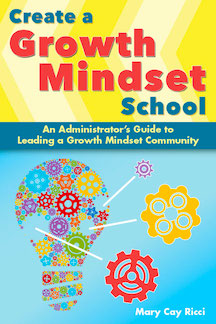Leading Growth Mindset Schools and Districts
Create a Growth Mindset School: An Administrator’s Guide to Leading a Growth Mindset Community
By Mary Cay Ricci
(Prufrock Press, 2018 – Learn more)
Carol Dweck’s Mindset was first published in 2006, but it wasn’t until a bunch of years after that I finally held a copy in my hands. I’d heard that this growth mindset thinking had gotten the attention of educators. Feeling a little behind the times, I read with interest.
I’ll never forget skimming the first few chapters. Fixed mindset? Yeah, that was me. Dweck’s research made me feel – well, skeptical. How could it be possible for the brain’s ability to change and grow, to increase intelligence fueled mostly by belief that it could?

One of my principal’s favorite lines is “It’s OK to be where you are – but it’s not OK to stay there.” Looking back over the years teaching after reading Mindset, I’d say this book has been the single most mind-blowing, game-changing, paradigm-shifting, impact-provoking thing that has happened to me as an educator.
Mary Cay Ricci’s Creating a Growth Mindset School begins there. Convinced that the belief in a growth mindset will make a vital positive impact on the culture of a district and ultimately, each individual student, Ricci’s slim, straightforward how-to guide is a utilitarian method of setting an entire school district – superintendent to custodian – on the same growth mindset page.
If Dweck’s Mindset research, after 20 years of publication and refinement, is like a well-oiled machine, then Mary Cay Ricci’s Creating a Growth Mindset School is a well-equipped tool-belt for administrators who want to instill a system that hums with the positivity of growth.
Setting a Foundation
Ricci’s audience is administrators: school leaders in the position of directing, orchestrating and evaluating change building-wide or over an entire district. Wisely, the first four chapters focus on determining the status of the administrator’s mindset.
The tools in these chapters are designed for reflection, which happens to be a key component in the development of a growth mindset. Questions, charts, videos via QR codes – here, and throughout the book – are a rich line-up of insight-producing food for thought. Chapters speak to the climate of school and to touchy subjects like “pot-stirrers” that negatively impact the optimistic morale so vital to growth. Indeed, morphing a staff into believing in all students does require optimism, perseverance and resiliency.
Administrators are the change agents who must effectively lead the charge. Clearly understanding the charge is, of course, paramount.
Teaching the Teachers
I am sure I’m not alone in my one-time ignorance and skepticism of the growth mindset. Professional development and persuasion are key elements for an administrator to tackle. Ricci addresses the barriers to getting everyone on board for an effort that can be sustained. She suggests practical and do-able procedures for the areas that growth mindset depend on: grading, learning environment, classroom and student body management, and hiring.
One subsection titled “Deliberate Actions” speaks to the (huge) little things teachers can do. “In the trenches, every day, this is what I say when students say this…” language can flip a teacher’s mindset message on its head.
Beyond the classroom, a chapter dedicated to bringing the idea to parents and the community contains resources for extending the philosophy into homes.
Reaching Every Student
I enjoyed imagining implementing the growth mindset-oriented lessons in the school building in disciplinary areas. Ricci has come up with ideas that feed the “power of yet” through presenting content and exercise methods that can be used routinely, again and again and again.
Building understanding of words like tenacity, grit, perseverance, persistence, stamina, endurance and resiliency are key to a growth mindset-ed individual’s sense of efficacy. These chapters are full of tips and links to resources that help teacher learn to talk the talk of growth mindset.
Where do we go from here?
Ricci wraps up with a chapter on two essential questions: At a Growth Mindset School, how can one tell if the philosophy is taking hold? and, Once achieved, how can the momentum be sustained?
Now, with my ten years of Mindset, the effect I’ve observed in kids is exciting and exhilarating. I love seeing the struggle of kids in my school working to achieve goals they set and being able to congratulate not just their achievement, but their persistence through the difficulties they experienced.
I love seeing students not one bit surprised at their growth, because they know how hard they worked. As I experienced myself as a teacher, a growth mindset is also a significant game-changer for so many students. In the words of Carol Dweck:
“Instead, as you begin to understand the fixed and growth mindsets, you will see exactly how one thing leads to another— how a belief that your qualities are carved in stone leads to a host of thoughts and actions, and how a belief that your qualities can be cultivated leads to a host of different thoughts and actions, taking you down an entirely different road.” Dweck (2006)
Creating a Growth Mindset School by Carol Cay Ricci is the power of yet on an amplified, multiplied, groupthink scale and is quite worthwhile for any administrator wishing to change the course of a building or entire district. We can grow and tap into the power of hope for a brighter, more successful future for so many students.
_____________________
In special, regular, and intervention classrooms, and now as school librarian at St. Croix Falls Elementary School in rural Wisconsin, Amy Klein has taught every grade. A National Board-Certified master teacher in Early Childhood and Middle Level Literacy, she holds degrees in English, Special Education and Reading, and has been pushing books on students, her husband, and her own four children for the past 21 years.



































